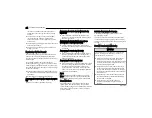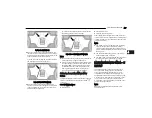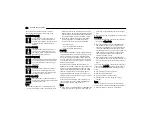
Curb Weight
The curb weight of a vehicle is defined as the total
weight of the vehicle with all fluids, including vehicle
fuel, at full capacity conditions, and with no occupants
or cargo loaded into the vehicle. The front and rear curb
weight values are determined by weighing your vehicle
on a commercial scale before any occupants or cargo
are added.
Loading
The actual total weight and the weight of the front
and rear of your vehicle at the ground can best be
determined by weighing it when it is loaded and ready
for operation.
The entire vehicle should first be weighed on a
commercial scale to ensure that the Gross Vehicle
Weight Rating (GVWR) has not been exceeded. The
weight on the front and rear of the vehicle should
then be determined separately to be sure that the
load is properly distributed over the front and rear
axle. Weighing the vehicle may show that the Gross
Axle Weight Rating (GAWR) of either the front or rear
axles has been exceeded but the total load is within the
specified GVWR. If so, weight must be shifted from front
to rear or rear to front as appropriate until the specified
weight limitations are met. Store the heavier items
down low and be sure that the weight is distributed
equally. Stow all loose items securely before driving.
Improper weight distributions can have an adverse
affect on the way your vehicle steers and handles and
the way the brakes operate.
WARNING!
Do not load your vehicle any heavier than the GVWR,
maximum Payload or the maximum front and rear
GAWR. If you do, parts on your vehicle can break, or it
can change the way your vehicle handles. This could
cause you to lose control. Overloading can shorten
the life of your vehicle.
TRAILER TOWING
In this section you will find safety tips and information
on limits to the type of towing you can reasonably
do with your vehicle. Before towing a trailer, carefully
review this information to tow your load as efficiently
and safely as possible.
To maintain the New Vehicle Limited Warranty coverage,
follow the requirements and recommendations in this
manual concerning vehicles used for trailer towing.
C
OMMON
T
OWING
D
EFINITIONS
The following trailer towing related definitions will assist
you in understanding the following information:
Gross Vehicle Weight Rating (GVWR)
The GVWR is the total allowable weight of your vehicle.
This includes driver, passengers, cargo and tongue
weight. The total load must be limited so that you do
not exceed the GVWR
.
Gross Trailer Weight (GTW)
The GTW is the weight of the trailer plus the weight of
all cargo, consumables and equipment (permanent or
temporary) loaded in or on the trailer in its "loaded and
ready for operation" condition.
The recommended way to measure GTW is to put your
fully loaded trailer on a vehicle scale. The entire weight
of the trailer must be supported by the scale
Gross Combination Weight Rating
(GCWR)
The GCWR is the total allowable weight of your vehicle
and trailer when weighed in combination.
Gross Axle Weight Rating (GAWR)
The GAWR is the maximum capacity of the front and
rear axles. Distribute the load over the front and rear
axles evenly. Make sure that you do not exceed either
front or rear GAWR
.
WARNING!
It is important that you do not exceed the maximum
front or rear GAWR. A dangerous driving condition
can result if either rating is exceeded. You could lose
control of the vehicle and have a collision.
Tongue Weight (TW)
The Tongue Weight is the downward force exerted on
the hitch ball by the trailer. You must consider this as
part of the load on your vehicle.
Trailer Frontal Area
The trailer frontal area is the maximum height
multiplied by the maximum width of the front of a
trailer.
186 STARTING AND OPERATING









































